Update and bump: I hate to rehash old stuff, but I added quite a bit of information to this post, including .pdfs of all the Barbeau letters, blue prints, etc. I’ve been doing quite a bit of work at this site lately, so it is in the front of my mind. I have also been reading about the Rural Radio Network, which covered western and central New York.
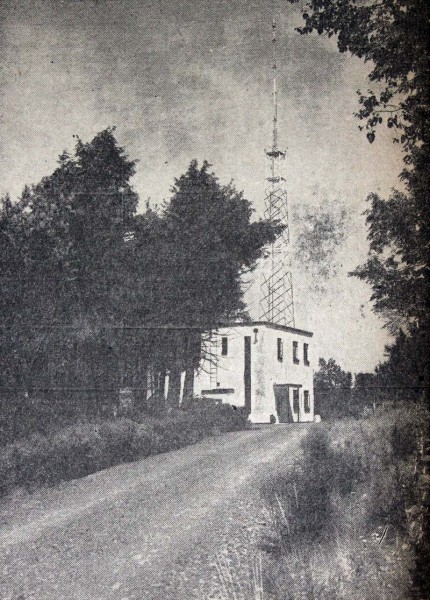
Several years ago, I rescued an old filing cabinet that was being trashed. This particular file cabinet was moved to a transmitter site during the great radio consolidation of the late 90s and early 00s. In it, I discovered a treasure trove of early documents about two radio stations from the Albany NY area. I thought it would be interesting to document the building of one of the early FM stations in Albany, WFLY.
Albany is the capital of New York. There were several early (prior to 1940) AM radio stations in the Albany area:
- WGY previously owned by General Electric in Schenectady, signed on in 1922
- WHAZ, previously owned by RPI (Rensselaer Polytechnic Institute), signed on in 1922
- WOKO (now WDDY), signed on in 1930
- WABY, (now WAMC-AM), signed on in 1934
General Electric, who worked closely with RCA in radio development and experimentation, was working on TV in 1928 and FM radio in 1938/39. There were also several early (prior to 1950) FM stations in the area:
- GE owned W2XOY on 48.5 MHz (circa 1939), later W85A, WGFM, and WRVE 99.5 MHz.
- Independently owned W47A on 44.7 MHz (circa 1940), later WBCA 101.1 MHz, now gone.
- WTRY owned WTRI-FM on 102.7 MHz (circa 1947), off air by 1954. 102.7 frequency later used by WEQX in Manchester, VT
- Troy Record owned WFLY on 92.3 MHz (circa 1948).
These stations operated from transmitter sites in the Helderberg escarpment on land that was formerly owned by the Albany Bible Institute. It is interesting to note that two of the four FM stations did not make it past 1955. In 1967, WTRY did make a second attempt at FM, launching WDKC on 106.5 MHz, which is today known as WPYX.
It would appear the Troy Record initially applied for an FM broadcasting license in late 1946. The paper trail that I found started in early 1947 when the station hired consulting engineer Ernest Barbeau of Schenectady to oversee the construction process for the studios and transmitter site. Ernest Barbeau, in an introductory letter to Frank York, publisher of the Troy Record, notes himself as a former GE engineer and assistant to W.R.G. Baker, General Electric’s television pioneer. At the time, it was already understood that height means almost everything in FM broadcasting. There are several letters dealing with land acquisition and transmitter building construction.
Below is a chart of all the various Barbeau letters written in 1947. I have scanned and uploaded .pdf files of each letter, sorted by date (the entire archive is available here (6.5 Mb .zip)):
| Date | From | To | Subject |
| Jan 3, 1946 (sic) | Barbeau | York | FM CP granted |
| Feb 5, 1947 | Barbeau | York | Studio location |
| Feb 8, 1947 | Barbeau | York | Coverage area, transmitter power, tower type |
| Feb 21, 1947 | Barbeau | York | Scheduling |
| Mar 7, 1947 | Barbeau | York | Transmitter/tower type, with attachments |
| Mar 9, 1947 | Barbeau | York | Electric/phone service |
| Mar 15, 1947 | Barbeau | York | DC consulting engineer John Barrons |
| Mar 23, 1947 | Barbeau | York | Scheduling |
| Mar 23, 1947 | Barbeau | Barrons | Transmitter site location |
| Mar 29, 1947 | Barbeau | Williams | Transmitter site location |
| Mar 29, 1947 | Barbeau | York | Transmitter site location, studio location |
| Apr 4, 1947 | Barbeau | York | Helderberg land owners |
| Apr 4, 1947 | Barbeau | Rogers | Camp Pinnacle |
| Apr 9, 1947 | Barbeau | York | Transmission line |
| Apr 9, 1947 | Barbeau | Van Antwerp | Camp Pinnacle |
| Apr 9, 1947 | Barbeau | Sherwood | Transcription service |
| Apr 21, 1947 | Barbeau | York | Helderberg land owners |
| Apr 21, 1947 | Barbeau | Rogers | Camp Pinnacle |
| Apr 21, 1947 | Barbeau | Rousseau | Helderberg land owner |
| Apr 21, 1947 | Barbeau | La Grange | Helderberg land owner |
| Apr 21, 1947 | Barbeau | York | WOKO |
| Apr 21, 1947 | Barbeau | Barron | Transmitter site |
| Apr 23, 1947 | Barbeau | York | Studio location |
| Apr 23, 1947 | Barbeau | Rousseau | Studio location |
| May 1, 1947 | Barbeau | York | Rogers land |
| May 21, 1947 | Barbeau | York | Rousseau land |
| May 29, 1947 | Barbeau | York | Camp Pinnacle |
| May 29, 1947 | Barbeau | Watson | Studio Floor plans |
| Jun 2, 1947 | Barbeau | York | Rogers land |
| Jun 2, 1947 | Barbeau | Rogers | Camp Pinnacle |
| Jun 10, 1947 | Barbeau | Velie (York) | Camp Pinnacle |
| Jun 10, 1947 | Barbeau | Reed | Camp Pinnacle |
| Jun 21, 1947 | Barbeau | Velie (York) | Camp Pinnacle |
| Jun 23, 1947 | Barbeau | York | Helderberg Land |
| Jun 27, 1947 | Barbeau | York | Helderberg Land |
| Jul 3, 1947 | Barbeau | York | Camp Pinnacle |
| Jul 5, 1947 | Barbeau | York | Helderberg land |
| Jul 15, 1947 | Barbeau | York | Schedule |
| Jul 23, 1947 | Barbeau | York | Camp Pinnacle |
| Aug 11, 1947 | Barbeau | York | Telephone facilities |
| Aug 14, 1947 | Barbeau | York | Telephone facilities, STL, land surveyor |
| Aug 16, 1947 | Barbeau | York | Land Survey, building location, costs |
| Aug 20, 1947 | Barbeau | York | Land transfer |
| Aug 20, 1947 | Barbeau | Barron | Transmitter building locations, FCC |
| Aug 25, 1947 | Barbeau | Rousseau | Studio location |
| Aug 25, 1947 | Barbeau | Winslow | Watson |
| Aug 29, 1947 | Barbeau | York | Telephone service, STL |
| Sep 8, 1947 | Barbeau | York | Pep talk |
| Sep 15, 1947 | Barbeau | York | Land transfer, survey, Watson, studio location |
| Sep 20, 1947 | Barbeau | Barron | Antenna type, mounting |
| Sep 23, 1947 | Barbeau | York | Pep talk |
| Oct 4, 1947 | Barbeau | Linge | Antenna mast |
| Oct 6, 1947 | Barbeau | York | FCC STL |
| Oct 6, 1947 | Barbeau | York | Call letter choice |
| Oct 7, 1947 | Barbeau | York | Well drilling, politics |
| Oct 10, 1947 | Barbeau | Barron | WBCA interference |
| Oct 14, 1947 | Barbeau | IDECO | Tower |
| Oct 14, 1947 | Barbeau | Lehigh steel | Tower |
| Oct 14, 1947 | Barbeau | Truscon Steel | Tower |
| Oct 14, 1947 | Barbeau | American Bridge | Tower |
| Oct 15, 1947 | Barbeau | York | Scheduling |
| Oct 15, 1947 | Barbeau | York | Building location, tower type, height |
| Oct 18, 1947 | Barbeau | York | Antenna mounting |
| Oct 20, 1947 | Barbeau | York | Access Road Location |
| Oct 27, 1947 | Barbeau | York | Antenna location, scheduling |
| Oct 27, 1947 | Barbeau | York | Land title, survey, well drilling, antenna height, FCC |
| Oct 28, 1947 | Barbeau | Torlish | Well Drilling |
| Oct 30, 1947 | Barbeau | York | Well Drilling |
| Oct 30, 1947 | Barbeau | Barron | Antenna mounting |
| Nov 4, 1947 | Barbeau | York | Scheduling |
| Nov 5, 1947 | Barbeau | Schenectady Steel | Support mast |
| Nov 5, 1947 | Barbeau | York | WTRY construction progress (WTRI-FM) |
| Nov 5, 1947 | Barbeau | Barron | Antenna mounting, STL |
| Nov 6, 1947 | Barbeau | York | Land survey |
| Nov 7, 1947 | Barbeau | Torlish | Well drilling |
| Nov 17, 1947 | Barbeau | York | Progress report |
| Nov 17, 1947 | Barbeau | Barron | Antenna mounting |
| Nov 17, 1947 | Barbeau | American Bridge | Tower |
| Nov 26, 1947 | Barbeau | Barron | Transmission line |
| Nov 29, 1947 | Barbeau | York | Transmitter building design |
| Dec 2, 1947 | Barbeau | York | Access road |
| Dec 3, 1947 | Barbeau | York | Contractors |
| Dec 8, 1947 | Barbeau | York | Contractors |
| Dec 9, 1947 | Barbeau | York | Contractors, tower erection |
| Dec 9, 1947 | Barbeau | Zane | Construction of Blaw Knox tower |
| Dec 9, 1947 | Barbeau | York | Tower erection, observations of WTRI tower |
| Dec 11, 1947 | Barbeau | York | Land clearing, building location |
| Dec 12, 1947 | Barbeau | York | Building location, driveway |
| Dec 14, 1947 | Barbeau | York | Studio location |
| Dec 29, 1947 | Barbeau | York | Construction start |
This is a treasure trove of information on how this, and perhaps other early FM and TV stations went about finding land and building remote transmitter sites. Remember that before this, AM transmitters could be placed in any convenient location with enough space for the tower and ground system. The line-of-sight nature of VHF required high locations, which in the Northeastern US, means prominent hills or mountains. Sadly, this paper trail goes away in 1948.
Here are some of the highlights found in the letters above:
- Washington DC consulting engineer for the project is John Barrons, who at one point suggested a different transmitter location closer to the city of Troy. Barbeau insists that the Helderberg location is best because the GE engineers chose it for their FM and TV experiments.
- Negotiations with several land owners along the edge of the Helderberg escarpment are finally successful, with a 10-acre parcel of land purchased from Mr. La Grange, noted as being across Camp Pinnacle Road to the south of the WBCA transmitter and adjacent to the west of the GE parcel, cost $2,000. From this, I surmise the former W47A/WBCA site stood where the former WHMT/WVCR site stands today.
- Land survey completed by Mr. J. Kempf of Albany.
- The FCC application is completed with a new transmitter location, antenna height, and frequency of 92.5 MHz (this was changed to 92.3 MHz prior to sign on).
- At one point, Barbeau tried to hire Walter Watson, an RPI architecture student, to draw up the studio floor plan, paying him $15.00. At first, Watson agrees, then backs out of the deal. Frank York hires an architect to draw the studio floor plan and the transmitter site-building plan.
- Once the plot of land for the transmitter site is purchased, several different building locations and antenna configurations are discussed. It is noted that both WBCA’s and WGFM’s original antenna was mounted on a pole at ground level. The later station was moved to a makeshift tower.
- WBCA management raises concerns with the FCC about potential interference from the new station’s transmitter and potential STL, noted as an S-T link.
- In September of 1947, Frank York expresses some concern with the viability of the project, Barbeau sends several “pep talk” letters saying that FM radio is the future of broadcasting.
- The building site is chosen, land cleared, access road installed, work done by Orsini Brothers Construction from Altamont, clearing and road work cost $2,000.
- The call letters WFLY are chosen, they are the initials of Frank Lloyd York.
- An 80-foot Blaw-Knox self-supporting tower is purchased and installed by Zane Construction, cost of the tower is $1,700 installation was another $200.00.
- The well is drilled by Stewart Brothers well drilling from Guilderland, cost of $5.90 per foot drilled, total cost unknown.
- Transmitter building work began, the building is noted as a two-story, concrete block construction, work done by Orsini Brothers.
- A GE BY-4-C four-bay
circularlyhorizontally polarized antenna and a 3 1/2-inch Andrew transmission line are installed on the tower. - Building construction progresses, and telephone and electric services are installed. Three-phase electrical service cost $2,100 from New York Power and Light.
- The studio site was chosen at the Troy Hotel in downtown Troy.
- Living quarters were constructed on the second floor of the building for full-time transmitter engineers.
- A GE BF-3A 3 KW FM transmitter was purchased and shipped.
- Building construction completed.
- The transmitter was installed and tested.
- Telephone circuits between new studio installed and tested.
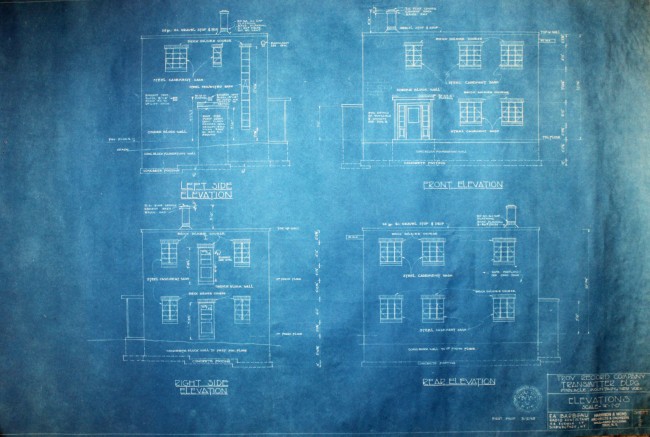
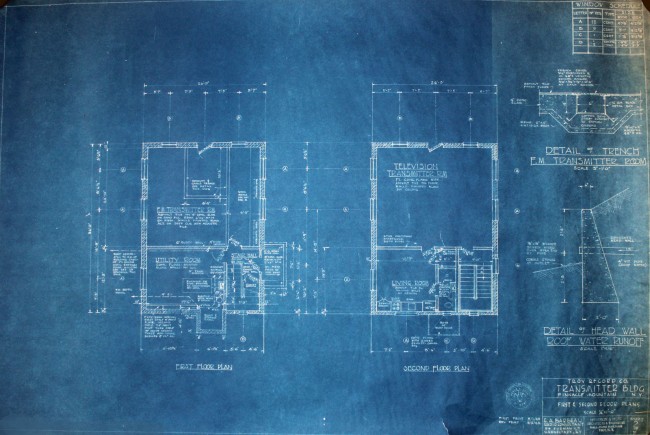
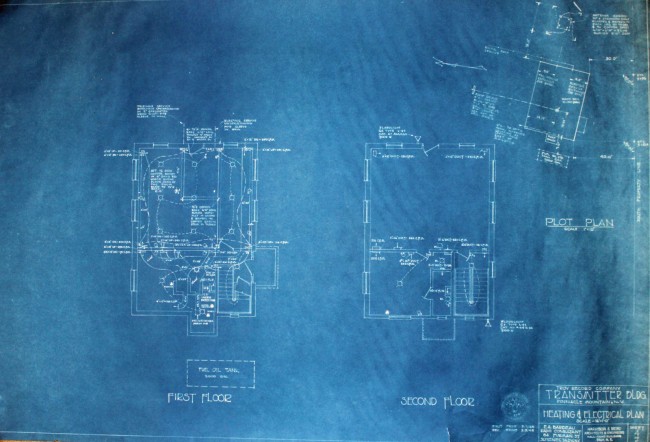
The transmitter site construction was finished in the spring of 1948. The studios were completed in late July of 1948 and the station signed on the air on August 18, 1948. This is the transmitter site that they ended up with. as it looks in 2015:
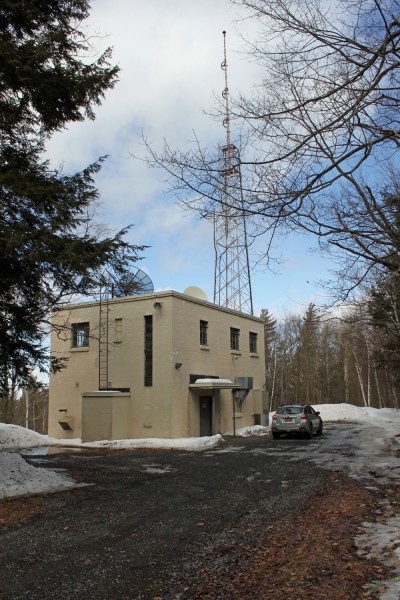
In addition to the construction, there was quite a bit of difficulty from the WBCA management, who were concerned about possible interference. WBCA was part of the “Continental Network” and received most of its network programming via direct over-the-air relay from W2XMN/W31NY, 43.1 MHz, in Alpine, NJ. They complained to the FCC about potential interference on both their over-air network relay (43.1 MHz) and the Studio to Transmitter Link from downtown Schenectady on 950 MHz. In the end, the FCC was unimpressed with these arguments and granted WFLY its operating license.
The transmitter building was made twice as large as needed because the Record had plans to launch a TV station and possibly a radio facsimile service. In addition to this, there were complete living quarters on the second floor which included a bathroom, shower, kitchen, bedroom, and large living room area. This was in the era before remote controlling of transmitters was permitted by the FCC. It took a hardy soul to live at the remote transmitter site full-time. Even today, it is far outside of town and can be difficult to get to in the wintertime
These mountain-top transmitter sites did not exist prior to the advent of TV and FM. The amount of planning and work that went into launching this station is quite impressive. For the early FM radio stations, this type of effort and expense was probably typical.




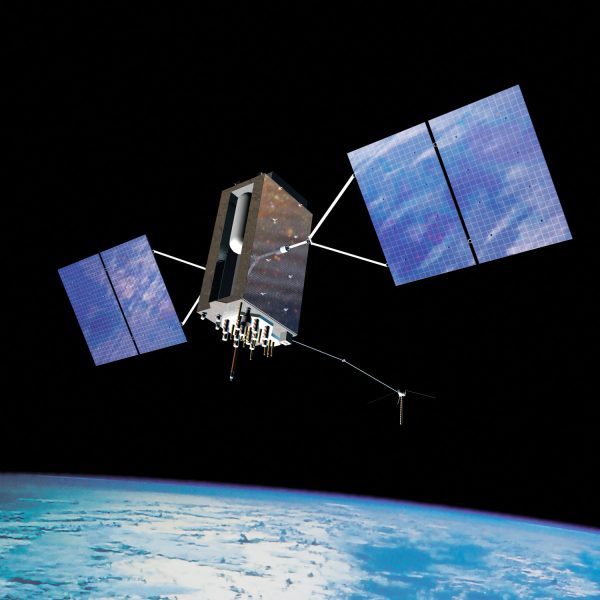
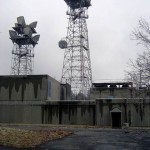
A classic postwar transmitter building. It looks very familiar. FM radio was cutting-edge new tech in those days and hopes were high. Very rare that those construction records survived, but they are a window into a vanished era.
Surprisingly it has taken 60+ years for FM to supplant AM as the dominant radio broadcast system.
Paul, I’m so happy that you found and preserved the files that I saved from the dumpster many years ago. The WFLY transmitter building of the late Bill Rust years was a storehouse of radio history, stacked to the ceiling with files and artifacts of early FM radio. The “Barbeau letters” To Frank L. York (on Hotel Ten Eyck stationary) that I saved are a treasure trove of history about Albany FM radio and how WFLY came to be built in the Helderbergs. With many misgivings, and because they were not mine, I left those files on the premises when I resigned from WFLY in 1986 with the hope that somebody following me would enjoy reading them as much as I did. When I visited the WFLY site in the early 2000’s with a mutual acquaintance of ours I looked for them and found them missing, and feared the worst. There was an equally valuable and enlightening file cabinet at the WPTR transmitter building which I presume was pitched many years ago. Happy New Year.
Jim, I forgot you worked at ‘FLY in the 80’s. Thank you for having the foresight to save these. I found them at the WROW-AM transmitter site. I should scan some of the more interesting Barbeau letters in, they are a hoot.
The WPTR files appear to be gone. The file cabinet, which was in your (and my) former office in the transmitter building, was cleaned out and reused for equipment manuals when the studios were rebuilt in 2005. When I was helping re-wire the studios, I asked what happened to all the stuff that was in the drawers and was told it was pitched into the dumpster. It made me almost sick. I know the mind at work here. Anyway, the good news, before I left WPTR, I made copies of the file regarding the 1953 plane/tower collision, which can be found here
Lee, even though it took many years for FM to be dominant, it had listeners almost right away. Along with the above files, I also have a large file folder with listener letters dating from 1948-53. There are many, often from great distances away.
I was not only at WFLY, I was the one who installed the new Continental transmitter, the ERI rototiller, and the Onan propane generator up there. When I arrived on scene, the building still looked exactly like the first photo you posted and was basically a time capsule. DG had the ground floor windows blocked up and we had the building painted the beige color you see now. The main rig was the Rockwell/Collins 10kW and I nursed along the original GE transmitter as an aux for as long as I could. We actually had two of those GE transmitters which were a 500 watt driver cabinet complete with the famous Phasitron tube exciter. A replica of that transmitter was built and used at the W2XMN Armstrong historic site in Alpine, NJ to mark the anniversary of FM radio a few years back. Our rigs also had the 3kW PA sections which had two finals in push-pull. I’ve long since forgotten the tube types, but we were forced to buy the Continental because of a pending power increase and tube failures in the GE which for which we couldn’t get Econco to rebuild the tubes anymore. The GE rig and its spares was given to a gentleman from the Syracuse area who collected vintage rigs and wanted to start a museum.
Three, full 60-yard dumpsters of trash and junque were removed from the WFLY building, and I cleared the trees that had grown almost to the tower base. There was a full 1940’s working kitchen which had been mothballed when the station went remote control in the 60’s and the last operators left. This included a full set of china, cookware and flatware carefully wrapped in tissue. Unfortunately I had to toss much of the kitchen inventory because the building was quite run down and everything was covered in mouse poop. There was a section of the top floor which had been walled off for a bedroom, complete with cot, matress, and panoramic views to die for. Operators used to spend a week on shift and several days off. If only that matress could talk!
It was my understanding that an FM license was sought by Frank York, the general manager of the Troy Record, believed he believed the future of newspapers was in OTA fax delivery via FM radio. He was not alone in that opinion, and was able to convince the board of the Record to fund what became WFLY. The FCC rules were different in those days and permitted the main channel to be used for non-program purposes prior to the advent of multiplexing, stereo and SCA’s.
The letters and status reports written by Mr. Lord’s consultant Ernest Barbeau are very detailed, and are written in a descriptive prose that one would expect from a man of his generation. Unfortunately those early pioneers like him are all gone now, and I hope you get around to scanning his notes someday because they are part of early FM history. I also recall leaving behind a copy of the Troy Record newspaper which was published on the day that WFLY signed on for the first time. The station’s birth coincided with the death of Gen. John “Blackjack” Pershing whose funeral was that same week.
The real mystery on Mt. Pinnacle is whatever happened to W44A which was on the prewar FM band. It was OTA around 1940, but did not make the move to the new FM band post-WW2. Ernest Barbeau did not mention it in his letters, and I assume it went dark during the war. Speculation is that the station was located on or near the GE property directly behind WFLY. I remember the remains of an old road going up the mountain behind our property. I believe Bob Levy was one of the WFLY transmitter operators who manned the Helderberg site. He used to be a regular at Albany SBE meetings during the 80’s and he may have some details on the history of the various sites, including W44A. In the 80’s he was CE at WHRL-FM, perhaps now long retired.
Too bad about the WPTR files. WPTR was another time capsule when I got there with not much having changed from the mid-60’s except for the Harris MW-50A coming online. Bob Henry, the WPTR engineer who witnessed the plane crash, was another regular at SBE meetings during the 80’s, but he was relunctant to talk about it anymore.
Oops, it seems I didn’t proofread my own blather. I remember hearing some dispute as to whether W47A/WBCA ever made it onto the post-war FM band. The mystery is still where the transmitter building was located as GE had always been behind the WFLY site.
Great post and even more interesting comments. Thanks for the good reading!
I once engineered at an FM site that had living quarters because it pre-dated (Rust) remote control authorization. It was the former WRLX in Auburn, NY. While only one story and not as large as WFLY’s, it was still pretty nice including a garage. It was originally built by the owners of radio, newspaper and cable TV in town before forced divestiture. The class B signal was in mono so covered the Finger Lakes and much of Central NYS.
Jim, Barbeau sheds some light on the location of the WBCA transmitter site. In his April 21, 1947 letter, he is describing the La Grange property (which is were the WFLY transmitter building is now located) “…it is at first blush even more desirable that (sic) WBCA’s site and is directly across the road (Camp Pinnacle Road) and to the south of WBCA.” In the same letter, it is also noted as being slightly higher than WBCA and has a better sight line into Albany and Troy than WBCA. From this, I surmise the WBCA transmitter was located where the former WHMT transmitter building now stands. WBCA disappears from the Broadcasting Yearbook after 1954, WMHT-TV went on the air in 1962.
Two more tidbits, and then I promise to pipe down. The WFLY transmitter site was a relay station for the old QXR network and once supported an elaborate antenna farm for receiving and relaying the signal from WQXR-AM in New York City. I remember finding detailed logs with remarks about the difficulty of receiving a usable signal from QXR. Then there was an RRN connection. WFLY was never a part of the old NY Rural Radio Network, but there are some similarities that the former RRN stations share with WFLY in their original equipment packages. I remember finding an old RRN mic flag in the WFLY transmitter building and I heard that RRN would sometimes take programming from the QXR network relays. It’s possible that some RRN programming may have entered the network from WFLY.
Paul, it’s been so long, but I recall reading that WMHT received a donation of property that it moved its transmitter to. So it’s possible that they got the site. But there was also a more extensive road network through the camp in previous decades.
Wonderful article! Thank you — the history of so many of these early FMs is fading rapidly.
OK, I’ll ask the dumb guy question – what’s the deal with the tall skinny window?
Jim, looking at the satellite imagery, I could be wrong about the WHMT site. It could actually be across the Beaver Dam Road. There is a house there now, but it looks like there are some building and road remnants in the woods. The only way to know for sure is to spend a day at the Albany County court house going over land records.
Spine, no such thing as a dumb question, the tall skinny window was for the staircase to the second floor. I am not sure about the proper architectural name, but the stairs go half way up to a landing, then turn 180 degrees the other direction the other half. It takes up a lot less space. On the second floor, the little skinny window to the right of the ladder is the bathroom, the other one is the kitchen.
The elusive W47A building would have looked like this: http://www.ggninfo.com/pix/w47a.jpg
A pretty nice transmitter shack itself.
Most broadcasters had no sense of or interest in their history. I worked briefly at WOKO and they had absolutely nothing on file or anywhere else that was more than 4 years old.
Wonderful read ! Hey Al Quaglieri! Worked with you for a very short time at WOKO!
I found your description really interesting. I would be really interested in the items on the well drilling and a general map of the location of this site. I spent a lot of years before becoming a ham involved with well drilling and groundwater and would like to put something together about the site.
Thanks Geddie, VE3CJX, St. Catharines Ontario, Canada
I was unaware that circular polarization was permitted at that early date. It took either twice as many antenna bays, with problems of shadowing for mountaintop sites, or twice the transmitter power, very expensive in the early days. It became much more important when people started listening to FM on car radios. Very interesting.
I also find the reference to a CP antenna interesting because I remember finding plans for an H-pol antenna in the transmitter building when I worked at WFLY in the mid-80’s. I presumed it was the original antenna which had been replaced at least twice before I got there. I believe that WFLY is still running on what may be its third or fourth antenna, a three-bay ERI rototiller which went up under my watch to replace an earlier rototiller that was leaking and damaged.
Two side notes…the original GE FM transmitter driver was a 250-watt cabinet, not 500-watts as I wrote earlier. Also, I found a New York State death record for a Francis York, aged 69, dated 1957. Frank York disappears from the Broadcasting Yearbook as GM of WFLY around 1960, but then the Yearbook was always a little behind the times.
Thought I’d also mention I’ve been trying to track down more information about the location of W47A/WBCA. That station was an early pioneer on the pre-war FM band and I find it amazing that so little is known or remembered about the station, even its transmitter location in the Helderberg tower farm. Almost all trace of it has been lost to history except for a couple of photos and print ads, and a chronology of Yearbook references. The early days of FM radio are quickly passing into ancient history and this is underscored by my experience this week. After a bit of surfing I came up with a connection between WBCA-FM and a gentleman who worked there in the early 50’s. A little bit more digging and I came up with a phone number. On a whim I called the number and it was answered by a voice who explained that he passed away three years ago. So it’s best to document that early radio history before it’s lost forever. Time runs through our fingers like sand, and before we know it we’ll all become statistics.
John/Jim, you raise an interesting question. In several of his letters, Barbeau describes the antenna as a “4 bay circular type antenna, 42 feet long.” Only once, in an October 30th letter to John Barron (DC Consulting Engineer) does he describe the antenna as “circularly polarized.” I did confirm the original antenna as a GE BY-4-C. Several of the older FM antennas did have circular elements, but were horizontally polarized, which may be the case here. If anyone has any old GE FM antenna literature, a quick look at a picture of the antenna would determine whether horizontal or circular polarization was used.
Update: I found the old GE antenna. It is either the original main antenna or a spare/backup antenna which is stored in the overhead above the generator. It is indeed only horizontally polarized. I’ll update the article and put up some pictures when I have a chance.
Paul, no need to apologize for updating your lovely site. History was never my strong suit in school but I appreciate more and more the process of looking back at how things got to be where they are, or how they used to be. And I used to live in New York, and went to school in the Capital Region though it’s been many years since I’ve been back. Thank you for continuing your work on this site!
I was the first program director of the old WDKC. Tried to model it after the CBS young sound.
I also helped to get WHRL on the air.
Bob Whyley… I remember you. In fact if I recall correctly, you would listen to radio station sign offs. And I remember when you worked at WHRL ( as did I ). I think that I met you at WMHT for a show call Our Inquiring Youth.
Unreal seeing your name pop up.
I also work all nights at WPTR in 1969 until 1971 .
They had a contest for the all night show only called the ” Far Out Contest “. The person who sent in a letter from the furthest location would win some prize. If I recall correctly, the winner was from Nova Scotia. And we did receive letters from 1500 miles away.
Personally, I would drive to Boston, and I could pick up WPTR in the downtown area of that city.
New comment to an old post but taking a look at https://www.historicaerials.com/ and using their tool / slider to compare aerial views between 1952 (earliest available) and 2019, there’s a much smaller building where the former WMHT analog site is today. The shape of the building vaguely resembles what I’d think W47A/WBCA would be from above, based on the limited photos of the facade that I’ve seen.
Where was the WTRI site?